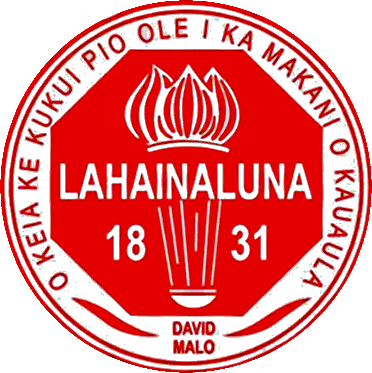Highlights:
On November 2, 1906, Queen Liliʻuokalani visited Lahainaluna to plant a tree. “This popular lady, though out of office, still reigns queen in the hearts of her people,” reported Maui News in its coverage of the event.

Queen Liliʻuokalani was here for Arbor Day and to witness one of Lahainaluna’s specialties: the throwing of poi. As Valerie Monson wrote for Maui News a century later, “the students would lop up poi on a finger or two and fling it into the bowls on the table.”
Apparently, our students did this with “such speed and accuracy” that they “never spilled a drop. Their talent became something to see.”
While the Lahainaluna “boyʻs string band” performed “a number of pieces,” the royal palm was planted “by Her Majesty’s own hands” on the spot in front of what is now the principal’s cottage. “Its verdant leaves,” the reporter concluded, “will help to keep ever green, in the hearts of her people.”
Today, there are at least 22 royal palms spread out around campus. Some of the most significant areas where you can find these magnificent trees are the pathway leading up towards the main office near the bandroom and boarders field. But none of them are believed to be the queen’s royal palm.
Around 2007, the queen’s royal palm, it is suspected, was knocked down. Yet, no one is certain about that. Tara Nakata, the librarian and member of the Archive committee, says “because the royal palm was never properly documented, we could only theorize what might have happened to it”--or where it even was.
“...it would be an honor to replace it.”
To restore the palm and connect to this important legacy, the Lahainaluna Boarders Alumni Association, Lahainaluna Boarding Department, Kanaeokana, and Kamehameha Schools Kaiāulu are working together to hold the Lahainaluna Boarders Ho’ike.
This event will take place on November 22, at our very own Hale Pā’ina from 2 to 8 pm. The Boarding Department will plant a few royal palms to honor our history with Queen Liliʻuokalani. A new tree will be planted and the history will be covered in depth.
According to Holly Chandler, Vice President of Boarding Operations, the event has a deep purpose. We can’t preserve what is lost, or even really confirm that the tree was removed, she suggested, but “it would be an honor to replace it.”
“Aunty Jane” Casco, a cafeteria staff member, agrees. The revival of the royal palm story and its ties to the Hawaiian kingdom will do us good, she said, because we are able to better acknowledge the rich history of the school.
Casco added that “The royal palm is a way for us to mālama, y'know take care, the land. It is a way for us to teach the younger generation to care for each other. Technology doesn’t do that for us.”
“There is a saying”, said Agriculture Teacher, Nathan Pallett: ”the best time to plant a tree is 20 years ago so you may bask in its shade today.”
Pallett admitted “I do not know of any significance royal palms have to Lahainaluna,” but if he were to “guess,” he added, “they have become a symbol of our school due to their regal appearance and age. So many have seen the palms over the many years that it seems everyone may recognize them as a symbol of our school similar to the torch in our school seal.”
Some other students think that the history of the royal palm makes is really why it's worth planting them. Annette Kohlepp, a freshman student thinks that planting could become a “tradition to bring back the history,” a reminder of Queen Liliʻuokalani’s legacy.
Jaiden Rante, another freshman student, says “I come to Lahainaluna, I see these royal palms the most.” After being informed of the history, Rante exclaims “it’s really cool that Queen Liliʻuokalani planted one of these before and that makes it even better that these are called ‘royal palms.’”
“...most of it is all just either dirt or dead.”
Senior border Kden Pu, thinks that there are more obvious reasons for an event like this. He mentioned how the area where the planting will take place “is all just either dirt or dead.” For this reason, he sees replanting “all the natural plants back and everything” as an act of “trying to give it back.”
The campus, although filled with an abundance of plants, can be brighter. Pu believes that they are “doing it to try to revive what is mostly there. And try to make it green again.”
Kaimana Borges, a sophomore, also agrees with Pu. Borges says replanting the royal palms can “add some color, as long as you guys water, keep on check.”
Pallet, who again, knew very little about the event, notes that there are real benefits to this kind of thing. “Planting trees, or any plant, in a space with intention and for a reason allows others to later benefit in many ways,” he said. “Productive landscapes can feed, heal, and create a source of income. Forest rehabilitation with native plants on a macro scale can fight the impacts of climate change, reduce soil erosion, and provide habitat for wildlife.”
“...I hope that they will grow also, strong and noble…”
On the original Arbor Day event, the queen, after the planting ceremony, allegedly turned to the principal, then C. A. McDonald, and said, “Tell the boys that as that tree grows up in strength and beauty, so I hope that they will grow also, strong and noble, and that they will be a pride to their parents, to the school, and to the country.”
This November we stand as proof of those feelings and as the school who has inherited this important legacy.
Kristina Meguro is a sophomore and a staff writer for Ka Lama Hawaiʻi.
Keiko is a staff writer for Ka Lama Hawaiʻi. She is currently a junior at Lahainaluna High School.

